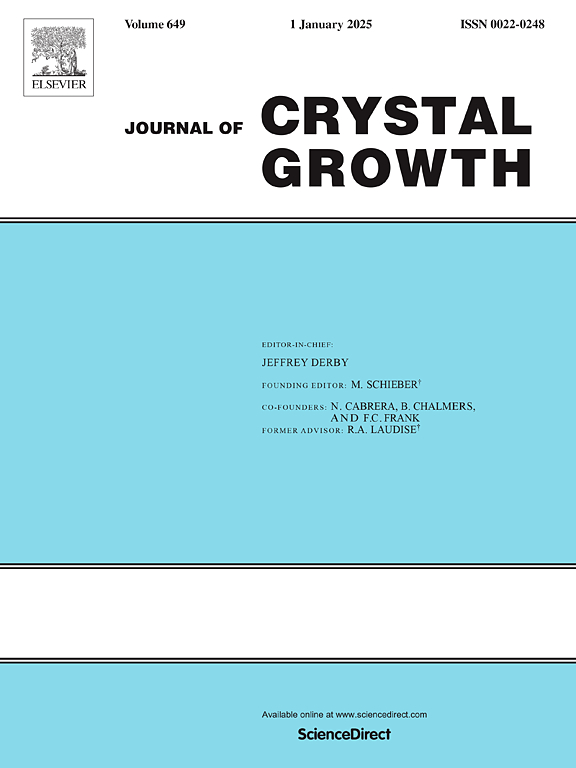多孔硅的热稳定:高质量SiGe外延的关键步骤
IF 2
4区 材料科学
Q3 CRYSTALLOGRAPHY
引用次数: 0
摘要
本文研究了多孔硅(PSi)上虚拟硅锗(SiGe)衬底的外延生长。在不同类型的PSi衬底上进行外延,有或没有事先热退火。原子力显微镜(AFM)、透射电子显微镜(TEM)和x射线衍射(XRD)的形貌和结构研究表明,在1100℃退火的双层PSi衬底上生长的外延SiGe薄膜的晶体质量明显高于在未退火PSi衬底上生长的薄膜或在低于或等于900℃退火的PSi衬底上生长的薄膜。这种改善是由于1100℃退火的有利影响,导致应力松弛,内部微观结构稳定和PSi表面形貌的显着改善。相反,在未退火PSi上直接生长SiGe,即使在中等温度(~ 400°C)下,也会导致多孔缓冲层的结构降解,导致外延生长的SiGe薄膜中的位错密度非常高。对PSi衬底的热处理进行了优化,促进了在PSi上生长高质量的虚拟SiGe衬底,这对于基于SiGe的光伏电池和微电子器件的开发既有效又经济可行。本文章由计算机程序翻译,如有差异,请以英文原文为准。
Thermal stabilization of porous silicon: A key step for high-quality SiGe epitaxy
This study focuses on the epitaxial growth of virtual silicon–germanium (SiGe) substrates on porous silicon (PSi). Epitaxy was performed on different types of PSi substrates, with or without prior thermal annealing. Morphological and structural investigations by atomic force microscopy (AFM), transmission electron microscopy (TEM) and X-ray diffraction (XRD) show that epitaxial SiGe films grown on double-layer PSi substrates, annealed at 1100 °C, exhibit significantly higher crystalline quality than those grown on unannealed PSi substrates or PSi substrates annealed at temperatures lower than or equal to 900 °C. This improvement is attributed to the beneficial effects of 1100 °C annealing, which leads to stress relaxation, internal microstructure stabilization and significant improvement of PSi surface morphology. In contrast, direct growth of SiGe on unannealed PSi, even at moderate temperature (∼400 °C), induces structural degradation of the porous buffer, leading to a very high dislocation density in the epitaxially grown SiGe films. A well-optimized thermal treatment of PSi substrates promotes the growth of high-quality virtual SiGe substrates on PSi that is both efficient and economically viable for the development of SiGe-based photovoltaic cells and microelectronic devices.
求助全文
通过发布文献求助,成功后即可免费获取论文全文。
去求助
来源期刊

Journal of Crystal Growth
化学-晶体学
CiteScore
3.60
自引率
11.10%
发文量
373
审稿时长
65 days
期刊介绍:
The journal offers a common reference and publication source for workers engaged in research on the experimental and theoretical aspects of crystal growth and its applications, e.g. in devices. Experimental and theoretical contributions are published in the following fields: theory of nucleation and growth, molecular kinetics and transport phenomena, crystallization in viscous media such as polymers and glasses; crystal growth of metals, minerals, semiconductors, superconductors, magnetics, inorganic, organic and biological substances in bulk or as thin films; molecular beam epitaxy, chemical vapor deposition, growth of III-V and II-VI and other semiconductors; characterization of single crystals by physical and chemical methods; apparatus, instrumentation and techniques for crystal growth, and purification methods; multilayer heterostructures and their characterisation with an emphasis on crystal growth and epitaxial aspects of electronic materials. A special feature of the journal is the periodic inclusion of proceedings of symposia and conferences on relevant aspects of crystal growth.
 求助内容:
求助内容: 应助结果提醒方式:
应助结果提醒方式:


